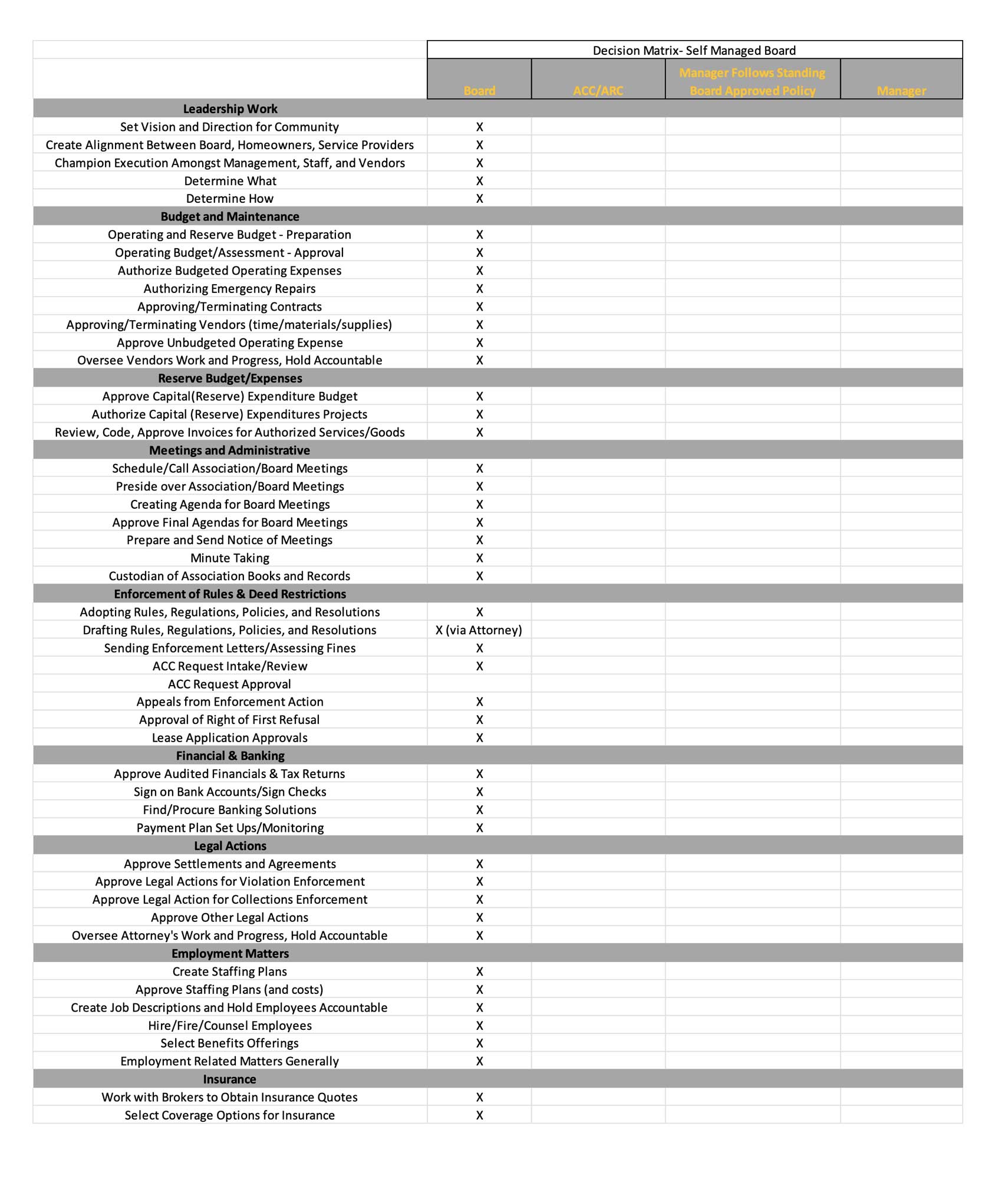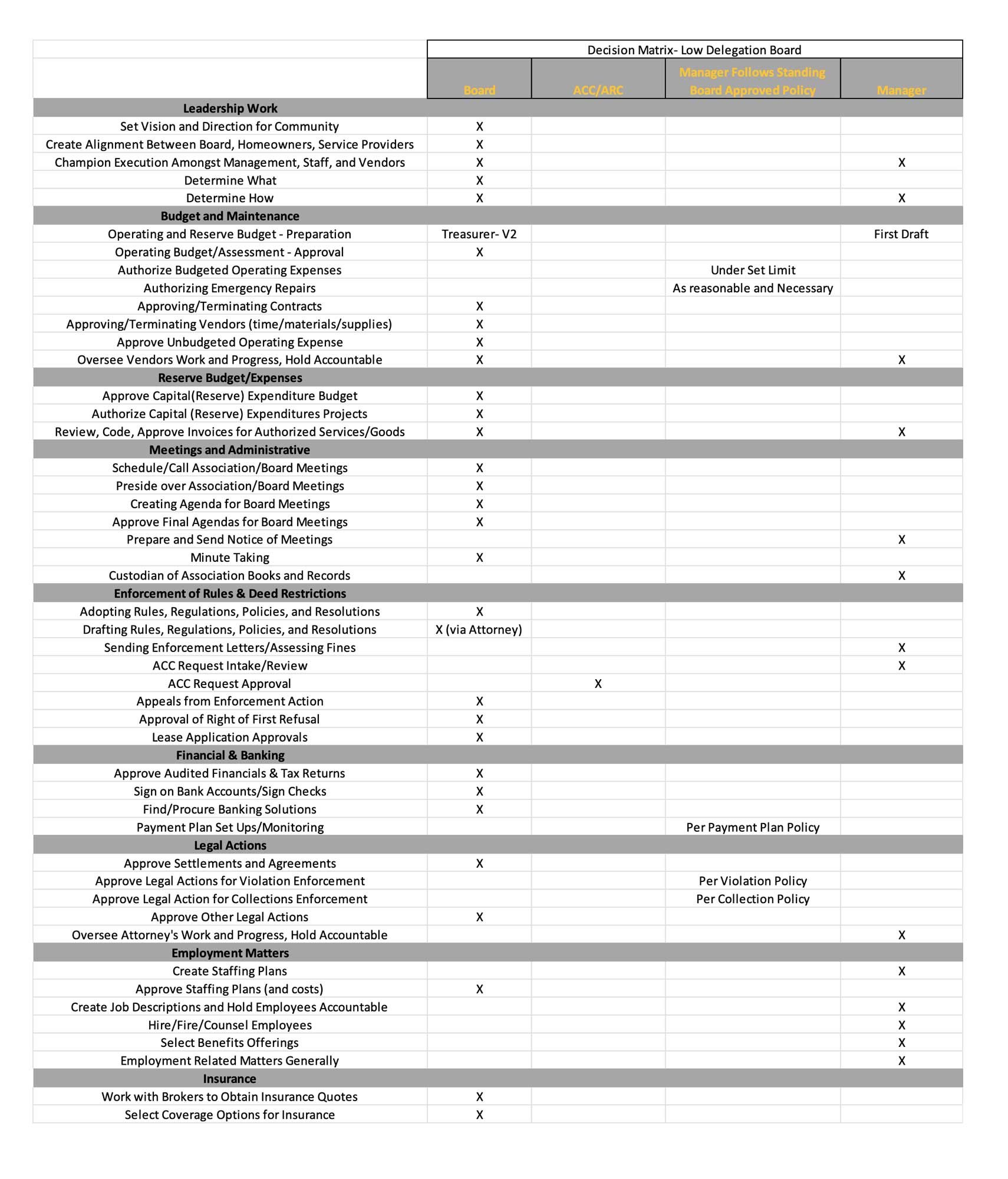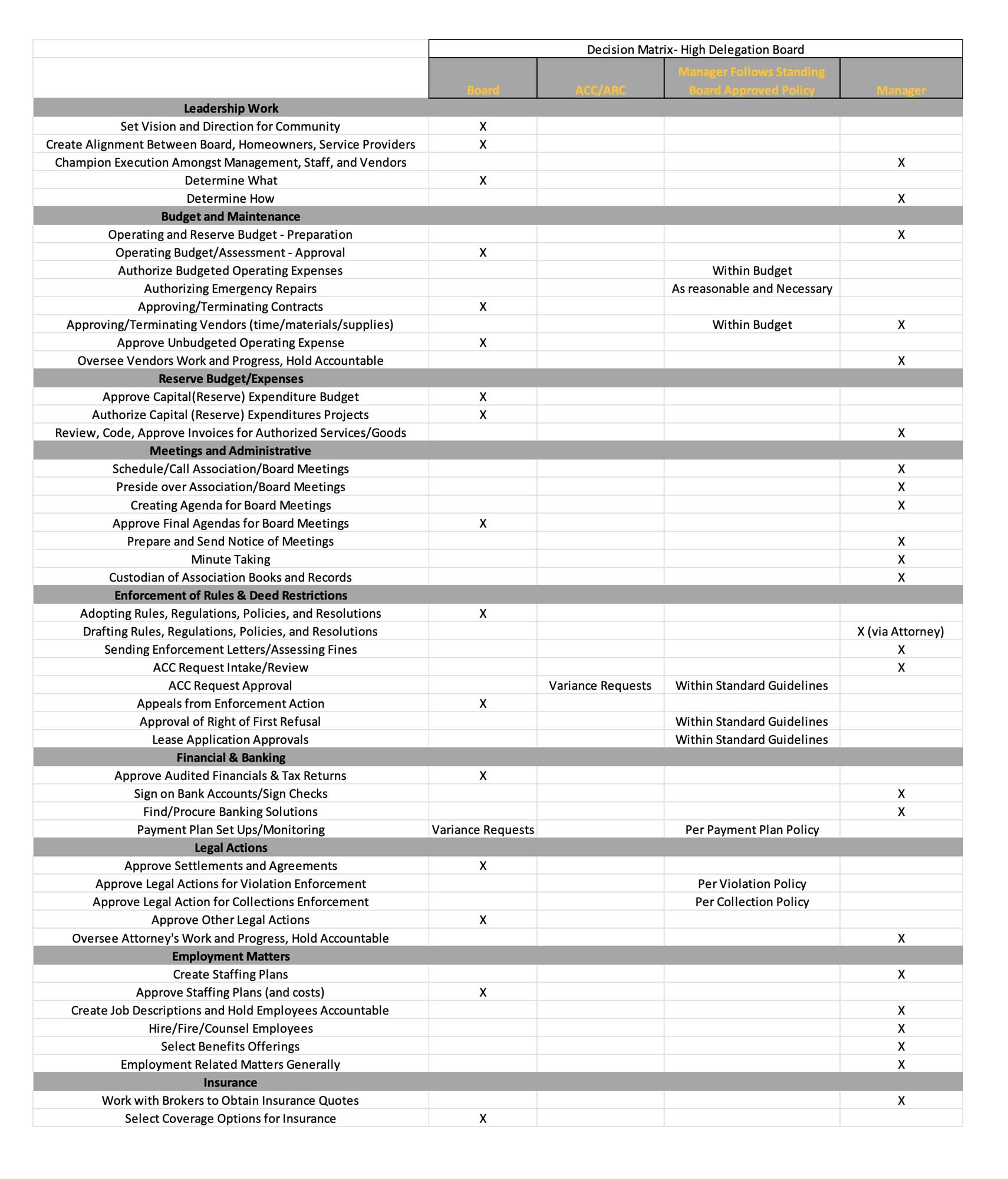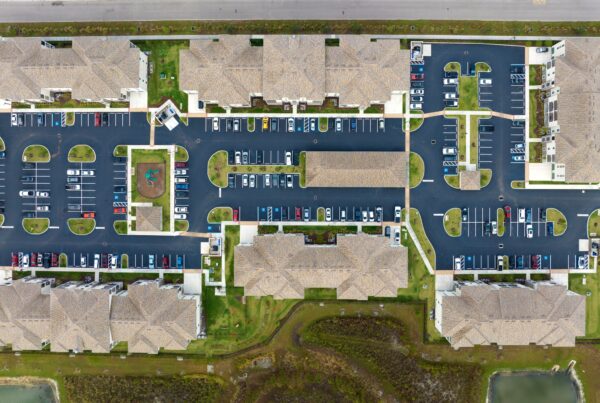The Role of the HOA Board vs Management Company
How Effective Role Identification Can Reduce Board Burnout and Increase Homeowner Satisfaction
Strong leaders help to build strong communities however the biggest threat facing your community may be that those leaders no longer have an interest in leading. According to CINC Systems’, a leading HOA management technology provider, 2023 State of the Industry Report, community leaders are calling it quits at an alarming rate due to factors such as rising homeowner apathy (or homeowner abuse), underfunded reserves, deferred maintenance, increasing HOA Board Member Duties and turnover of HOA management staff all of which leads to increased stress and workload for the volunteer HOA board members which contributes to an already challenging role for leaders of HOA communities. HOA Board Member burnout is among the top concerns cited by both HOA Board Members and HOA Managers alike in the recent publication. Further, these impacts are not isolated to HOA Board members but have also spread to include HOA Management staff, who often share in these burdens. Meanwhile, with workloads and challenges at an all-time high, still more than 56% of homeowners surveyed cited dissatisfaction with the management of their HOA during this period. So, with HOA Boards and HOA Managers working longer and harder than ever, and still experiencing increasing homeowner dissatisfaction, it is time to reexamine what are the responsibilities of the HOA Boards and what are the responsibilities of HOA Management in the modern era.
How you define the HOA management company responsibilities versus the HOA Board responsibilities is critical in identifying root causes of burnout. So, what is the difference between the roles of the HOA board and HOA management? The old wisdom more or less states that role of the HOA Board is to make the decisions, within the bounds of the powers, duties, and responsibilities outlined in the HOA’s governing documents to govern the affairs of the Association, and it is management’s responsibility is to carry out those decisions. However, HOA Boards face more decisions than ever which often need to be made faster, while they themselves struggle to find the time to thoughtfully consider each of the many thousands of decisions requiring their attention each year. The increasingly complex environment of HOA Management, and the expectation from homeowners of fast and transparent communication, access to HOA board members, and that HOAs use technology effectively further challenges these institutions to adapt to the homeowner of today. Failure to effectively address these challenges is partly to blame for HOA board member burn-out, poor homeowner satisfaction with their HOA and/or management, and increasing tensions between homeowners and board members. With tens of thousands of operational decisions to be made each year, this level of operational involvement on the part of the HOA Board sets the state for decision-making paralysis, inconsistent enforcement, and frustrated managers who cannot resolve homeowner issues timely. This article aims to reexamine these roles and provide recommendations on how to form a synergistic relationship between the board and management to prevent Board and management burnout through clearly defined roles.
Defining the Role of the Board of Directors, HOA Management, and the Association
Start by asking: What is the core purpose of an HOA or COA?
The HOA exists to serve specific purposes, such as enforcing deed restrictions, maintaining and operating common facilities, and preserving or enhancing property values in the community. The scope of the Association’s operations can vary wildly from larger ones which may run resort-like operations to smaller ones which may simply maintain a flowerbed at the entry. This depends largely on the type of property or operations it is responsible however at its core the purpose of the HOA, at a high level, is to maintain or enhance property values by enforcing governing documents/deed restrictions and operating and taking care of the common facilities.
What are the responsibilities of the HOA Board of Directors?
Regardless of which type of Board it is, all Boards of Directors are stewards of their associations, responsible for enforcing rules, maintaining association facilities and common areas, making business decisions in the interest of the association, and ensuring they align with the interests of the members as a whole, while also focusing on the association’s long-term welfare.
The board serves as the governing body of the association, setting the overall vision and direction. Key HOA Board Member Duties include:
- Establishing and enforcing community rules and regulations.
- Making significant financial decisions, including budgeting and allocation of funds.
- Overseeing legal compliance, such as adhering to state-specific laws like the Texas Property Code.
- Decision-making on policy level including policies on enforcement, community welfare, and long-term planning.
Certain Texas Condominiums formed after the Texas Uniform Condominium Act must fulfill a fiduciary duty to both the members and the association. However, for single-family HOA boards, this fiduciary duty exists only if specified in the association’s governing documents.
Does an HOA need a management company?
The Board of Directors is charged with making the decisions and exercising the authority delegated to it in the Bylaws and other governing documents. This is generally summed up as “governing the affairs of the Association.” In practice, this entails all operational, administrative, compliance, legal, collections, enforcement, and financial aspects of the association which can present an overwhelming amount of expert work and time required of a volunteer HOA Board. HOA/COA Board members are not typically permitted to be compensated and thus seldom can commit the necessary time, and expertise, nor do they generally have the risk tolerance to carry out these functions without support of a manager or management company. Even in smaller community associations, this can present a daunting task for volunteers. For larger more operationally complex communities such as those with resort-style amenities the number of decisions that must be considered increases exponentially. The institution of a HOA/COA, which runs more like a small municipality, isn’t well suited to convening, considering, and making the volume of decisions on this scale. Even in such cases as where the Board of Directors may have the desire to make these decisions, the HOA Board’s operating structure itself faces certain limitations. For example, in Texas, condominium boards can only make decisions in meetings or by unanimous written consent and single-family Boards of Directors must provide 172-hour notice of a meeting. Virtually meetings and conference calls also have limitations as to what kinds of business can be considered in a virtual setting. This hiring an effective HOA management company helps to both support community operations and prevent volunteer burnout. maintain transparency boards are not designed to keep up with the speed of large-scale operations.
What are the responsibilities of an HOA Management Company?
The scope of HOA management services provided can vary depending on the management company and the needs of the community. Generally, the HOA management company carries out the direction of the HOA Board and serves as an agent of the HOA in its dealings with outside parties, including the owners in the community, which can be a great relief to the HOA Board. The Board typically delegates certain responsibilities to the management company via a management contract to effectuate on its and the Association’s behalf. These duties typically include enforcement of the Association’s governing documents, accounting, financial functions, property maintenance functions, deed restriction enforcement, general administrative functions, staffing, and other operational needs however it is important to note that not every management company offers this complete scope of services. The Board retains decision-making authority for things outside of the scope it has delegated to management, usually reserved for significant decisions or policy-level decisions, however typically retains the right to step in and more specifically instruct or overrule management.
Knowing your desired scope will inform how to choose a management company for your homeowners’ association that offers the appropriate scope of services. This will help ensure aligned expectations (and ability to perform on these expectations) from the HOA board of directors, homeowners in the community, as well as management staff.
How to Help Prevent HOA Board Burnout Through Role Identification
Establish a Point of Contact from the Board of Directors to Management
Have you ever worked for more than one boss at the same time? If you have, then you know how frustrating it can be to do your best to follow a directive only to later be told that you were wrong for doing so or worse, you’re given a conflicting direction. That is the world of an HOA Community Manager when there is not a clear chain of communication. This is one of the top contributors to Board and Manager burnout: misalignment and moving goals posts.
Recommendation: To start, it’s essential for the board to designate one specific board member to serve as the intermediary between the board itself and the managing agent. Usually, this role falls to the President however any Board Member can fulfill this role. The role is not to make decisions on behalf of the Board but rather to convey direction and decisions made by the Board. The managing agent has the legitimate expectation to follow the instructions provided by this designated board member. If, at any point, it becomes evident that the communication from this board member does not accurately represent the collective consensus of the board, the board should consider appointing a new liaison. However, it’s impractical to anticipate that the managing agent can effectively handle communications with multiple board members or decipher conflicting directives from different board members on a regular basis. This is certain to lead to both Board and Management dissatisfaction.
Create a Clear Division of Responsibilities to Prevent Burn Out and Violated Expectations
The Board acts as the governing authority for the Association and its actions are that of the Association, so in this sense both management and the Board are working in service the same principal: the Association. Some perceive that the management company serves the Board but while in practice the management company is instructed by the Board, this is technically misleading because both bodies are in service of the Association.
One of the primary challenges is that is often not clear to all parties which specific decisions should be made by management versus those reserved for the board. Parties on both sides of this equation often have differing ideas about where this line exists causing misaligned expectations which lead to confusion and frustration. A clear delineation of responsibilities helps in ensuring that both the board and the management company understand their specific roles, leading to more effective governance and management. Although you may see articles stating that all decisions must be made by the Board of Directors the truth is that there is no one right way to do this except: it should be clear, in writing, understood by all, and should not something specifically required by law to be reserved for the Board of Directors.
Recommendation: Create a responsibility matrix as a reference guide for HOA Board members and management. At meetings refer back to this tool to help prevent parties from mistakenly drifting into micromanagement. See the example responsibility matrices included to illustrate a self-managed community as compared to a professionally managed community. There is no one right way to do this as you can see differences between low delegation boards and high delegation boards.
Prevent Decision Making Overload With Written Policies for Faster, More Consistent, Decision Making
Imagine you’re at the Board Meeting and are now being asked to make decisions on payment plan requests, violation enforcement actions, collections actions, how to respond to a written request for records, and who should pay for the cost to repair common property that was damaged by the guest of a homeowner. How long would it take to get through these agenda items without written guidelines on how to handle each? Believe it or not every single one of these decisions can be predetermined by written policy. Decision-making is a significant challenge, especially considering the volume of decisions required to run an association effectively and the fact that decisions typically happen at Board meetings and mostly in open sessions. This can create bottlenecks to decision making which can harm the Association if allowed to go on. As we’ve mentioned, there are tens of thousands of decisions that go into running the business of the Association. Imagine having to have a meeting every time a homeowner requested a payment arrangement or to decide whether to send delinquency notices to late payors- you may find yourself in a lot more meetings that run much longer.
Recommendation: Use policies and procedures as decision-making tools and then delegate their execution to management. Choose the most voluminous, routine, and types of operations and create clear policies that govern how management will handle them. Examples of useful and necessary policies are Collections Policies, Fining and Enforcement Policies, and a Maintenance Responsibility Matrix. This allows homeowners, board members, and management to remain aligned as to how things should work which is certain to help improve your homeowner satisfaction while reducing the workload of your board members. Imagine how unhappy you would be if you made a request to your HOA for something simple and routine only to be told no decision will be made until the next quarterly meeting only to find that the eventual decision didn’t seem to follow the governing documents. The added bonus is that this will allow the Board to protect their time and focus on crucial big decisions affecting the long-term welfare of the community rather than minutia.
Rely on Professionals to Follow Policies Intended to Prevent Discriminatory Treatment
Texas Property Code 202.004, which applies both to Texas Homeowners Associations and Condominium Associations, requires that enforcement decisions not be arbitrary, capricious, or discriminatory. Many Boards may feel that being involved in decision making related to routine policy enforcement is to the benefit of the Association. However, when working with a competent manager who has clear policies to enforce, too much Board involvement in this can have the opposite affect because it invites the perception of unequal treatment. Many Board think of “discrimination” as being on the basis of age, race, gender, or country of origin however any unequal treatment that creates arbitrary or capricious enforcement can meet this definition. Think of a scenario where a good friend or former board member is allowed a special exception to a standard policy- this is a form of discriminatory treatment which must be avoided.
Recommendation: Boards should, after the adoption of clear guidelines, delegate the enforcement of rules and day-to-day dispute resolutions to management companies to minimize biases and reduce the litigation risks for board members. Conflict resolution and the fear of litigation are common issues. Management companies, as neutral third parties, can mitigate this by handling enforcement and operational decisions impartially provided that you have clear rules and regulations that management has been empowered to enforce.
Leadership for On Site Management Personnel
It is common for Community Associations to have on site staff members who are either employees of the management company or direct employees of the Association. However, the line between the role of the Board Members and the Employer can blur in situations where there is not clear leadership for on site personnel. Board Members often step into a quasi “manager” or “employer” function out of a desire to ensure positive outcomes. However, often this simply adds to the burden of being a board member when establishing clear chain of accountability within the management hierarchy can offer more sustainable approach. Further, this approach allows Board Members to maintain impartial relationships, insulation from employment-related claims, and avoids confusion or frustration related to conflicting directions offered to staff which can lead to employee dissatisfaction or turnover.
Recommendation Utilize management companies that take care to engage its on site team members, provide regular coaching and feedback, as well who solicits board member feedback so as to better manage on site team accountability. This helps protect the Board, ensure consistent coaching and feedback to team members, and promotes healthy work environments. As a Board it is a best practice to avoid direct management of employees except through the manager or management company.
Use Technology To Improve Communication with Homeowners
Inefficient communication can lead to management challenges and Boards being surprised by owners as to certain developments. An informed Board is critical, even if certain tasks have been delegated to management. It is often the absence of clear communication that causes Board Members to feel the need to retain direct control of certain activities which might others be best carried out through set policies. Notably, the lack of communication from the Board and/or Management was cited as a leading reason for homeowner dissatisfaction with their HOA.
Recommendation: Ensuring that Management adequately reports on progress will help your Board stay in the loop on important developments without creating delays in management’s ability to carry out its delegated duties. This yields both transparency and efficiency. Weekly Management Reporting is our recommended best practice. Utilizing technology such as shared task lists to help capture comments, feedback, and decisions is also imperative to prevent email overload.
Conclusion
The relationship between HOA/COA boards and management companies is integral to the smooth functioning of associations. Today’s fast-paced environment requires an evolving understanding of how the roles of the board of directors and management can complement one another to be more effective. Respecting each other’s roles while working collaboratively can significantly address the challenges faced by boards. Through clear communication, effective delegation, and strategic partnership, boards can navigate the complexities of association management, ensuring a harmonious and well-maintained community. This can help to reduce board burn-out and improve homeowner satisfaction by creating a top-down alignment and allowing management to make fast decisions.










